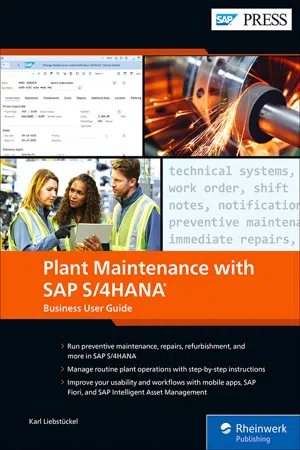
This is a test
- 665 pages
- English
- ePUB (mobile friendly)
- Available on iOS & Android
eBook - ePub
Plant Maintenance with SAP S/4HANA: Business User Guide
Book details
Book preview
Table of contents
Citations
Frequently asked questions
At the moment all of our mobile-responsive ePub books are available to download via the app. Most of our PDFs are also available to download and we're working on making the final remaining ones downloadable now. Learn more here.
Both plans give you full access to the library and all of Perlego’s features. The only differences are the price and subscription period: With the annual plan you’ll save around 30% compared to 12 months on the monthly plan.
We are an online textbook subscription service, where you can get access to an entire online library for less than the price of a single book per month. With over 1 million books across 1000+ topics, we’ve got you covered! Learn more here.
Look out for the read-aloud symbol on your next book to see if you can listen to it. The read-aloud tool reads text aloud for you, highlighting the text as it is being read. You can pause it, speed it up and slow it down. Learn more here.
Yes, you can access Plant Maintenance with SAP S/4HANA: Business User Guide by Karl Liebstückel in PDF and/or ePUB format, as well as other popular books in Ciencia de la computación & Ciencias computacionales general. We have over one million books available in our catalogue for you to explore.
Information
1 Introduction to Plant Maintenance with SAP S/4HANA
This chapter takes a look at the increasing significance of plant maintenance and the associated change in perspective, which has also given rise to new terminology. It then outlines the environment of SAP’s Plant Maintenance component.
In the past few years, plant maintenance has become more and more important for the following business, economic, and technological reasons:
- Business factors
- Rising acquisition values for technical systems
- A disproportionate increase in costs resulting from losses
- A higher, modified requirements profile for maintenance activities
- The need for real-time collaboration with customers and vendors
- Reduced vertical integration
-
- Economic factors
- An increasing proportion of maintenance costs attributable to the gross national product (GNP)
- Continuous growth in the number of people employed in the maintenance sector
- More stringent environmental regulations and occupational health and safety regulations
- Globalization of product markets
- Expansion of the services sector
-
- Technological factors
- Increased innovation speed
- Increased automation
- Increasingly interlinked, complex technical systems
-
This chapter will closely examine these influencing factors, all of which interact, and the associated changes to plant maintenance. Furthermore, this chapter will introduce the many changes that the maintenance components in the SAP system have undergone. It will also provide an overview of the application system of SAP S/4HANA, introduce the SAP HANA database, and discuss the three main user interfaces for SAP S/4HANA.
1.1 Plant Maintenance Today: New Ideas Need New Space
More and more companies are abandoning the outdated view that plant maintenance is a necessary evil or simply a cost factor. The ever-increasing pressure to be competitive in terms of quality and productivity is driving companies toward plant maintenance, which today occupies a much higher position in a company’s priority list of objectives than ever before. This extends to the realization that a company can sell its plant maintenance services in the market and thus can contribute to increased revenue in addition to reduced costs.
Market globalization is increasingly leading to close collaboration with customers and vendors. Vertical integration is becoming lower and lower. Thus, in the automotive industry in 2015, vertical integration dropped considerably, to just 23%, and to 10% in individual cases, such as for the Porsche Cayenne. That is, the automotive industry produces just 10%–25% of the end product itself, and everything else comes from upstream production stages: the suppliers. As a result, dependency on the availability of technical systems at upstream production levels has increased proportionately.
In the past, a company could take internal countermeasures against malfunctions within the production flow of deeply structured production processes, but these c...
Table of contents
- Dear Reader
- Notes on Usage
- Table of Contents
- Foreword
- About This Book
- 1 Introduction to Plant Maintenance with SAP S/4HANA
- 2 Organizational Structures
- 3 Structuring of Technical Systems
- 4 Work Order Cycle
- 5 Preventive Maintenance
- 6 Other Business Processes
- 7 Integrating Applications from Other Departments
- 8 Plant Maintenance Controlling
- 9 New Information Technologies for Plant Maintenance
- 10 Usability
- A List of Further Sources and Literature
- B Overviews
- C The Author
- Index
- Service Pages
- Legal Notes